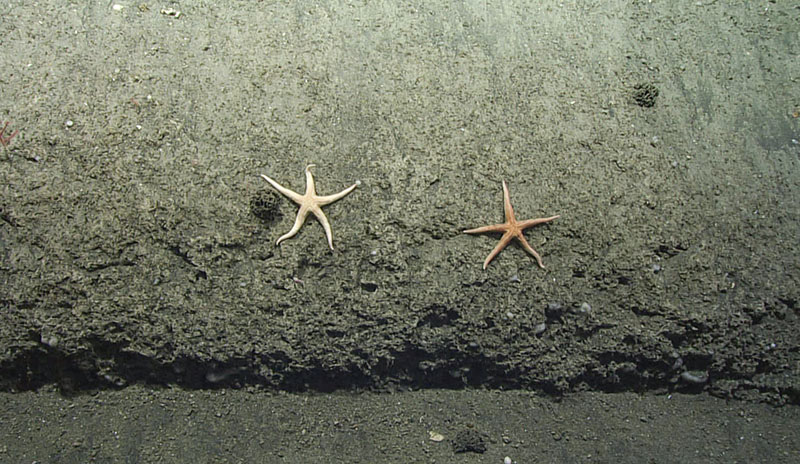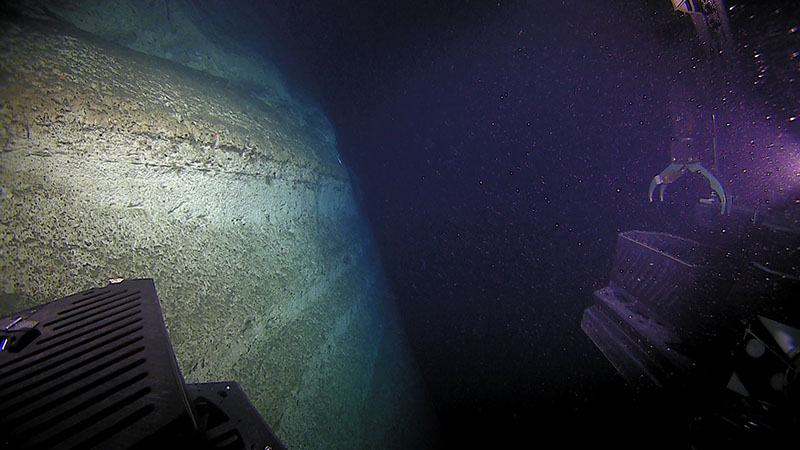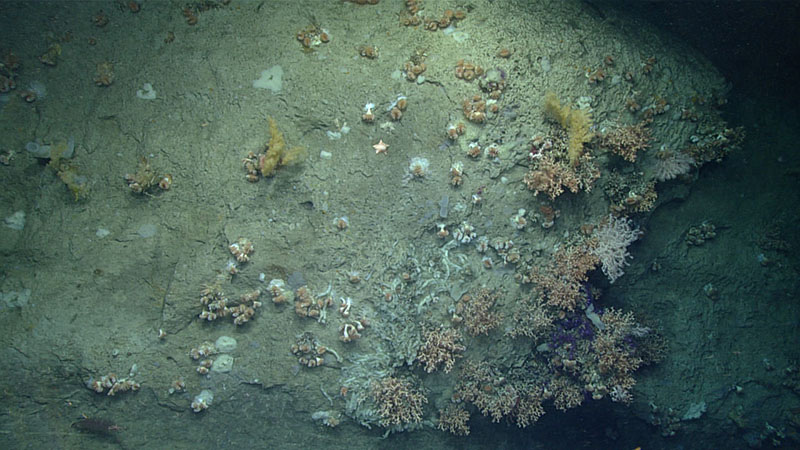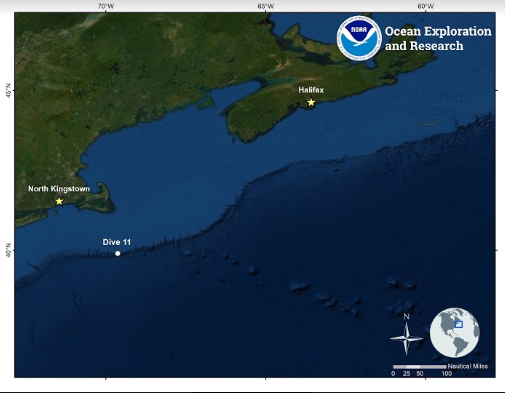
Date: September 12, 2019
Location: Lat: 39.84865°, Lon: -69.55360°
Dive Depth Range: 1,195 - 1,341 meters (3,921 - 4,400 feet)
Access Dive Summary and ROV Data
The ROV Deep Discoverer explores a sheer carbonate wall over 120 meters in height—taller than the Cliffs of Dover. Video courtesy of the NOAA Office of Ocean Exploration and Research, Deep Connections 2019. Download larger version (mp4, 80.1 MB).

ROV Deep Discoverer surveying a stunning, near-vertical sequence of carbonate rock at Veatch Canyon. The wall was over 100 meters thick. Image courtesy of the NOAA Office of Ocean Exploration and Research, Deep Connections 2019. Download larger version (jpg, 710 KB).
Today’s dive sought to explore the eastern wall of Veatch Canyon, in a region that has not yet been surveyed by deep-sea submersibles. The site was selected because habitat suitability models predicted that this area could contain suitable habitat for deep-sea corals.
Upon reaching the seafloor, we found soft sediments characteristic of most canyon axes at this relatively deep depth (~1,300 meters, or 4,265 feet). Bottom fauna were typical for this substrate, and included hake, halosaurs, cut throat eels, xenophyophores, deep-sea red crabs, and pancake urchins. Clasts and boulders of carbonate rocks with encrusting organisms were also observed on the canyon floor, and increased in density as the remotely operated vehicle (ROV) reached the foot of the slope.

These sea stars (Neomorphaster foricpatus) were a common sight during the dive at Veatch Canyon. Image courtesy of the NOAA Office of Ocean Exploration and Research, Deep Connections 2019. Download larger version (jpg, 1.3 MB).

The mechanical arm of ROV Deep Discoverer can be seen while surveying a stunning, near-vertical sequence of carbonate rock at Veatch Canyon. The wall was over 100 meters thick. Image courtesy of the NOAA Office of Ocean Exploration and Research, Deep Connections 2019. Download larger version (jpg, 976 KB).
As the ROV neared the end of the canyon axis, slopes increased dramatically giving rise to a massive, sheer carbonate wall, greater than 100 meters (328 feet) in thickness. The wall was sparsely encrusted with primnoid corals, cup corals, and encrusting demosponges. Two samples were collected during the dive, a bamboo coral and a plexaurid coral. As the dive concluded, a very dense assemblage of black corals, cup corals, hard corals, and purple stoloniferous corals was observed.

A dense community of corals and sponges, including cupcorals, Acanthogorgia sp. octocorals, and Lophelia pertusa hard corals, was seen towards the end of the dive at Veatch Canyon. Image courtesy of the NOAA Office of Ocean Exploration and Research, Deep Connections 2019. Download larger version (jpg, 1.2 MB).
Later in the evening, after the ROVs had been recovered, Expedition Coordinator Dr. Daniel Wagner and Geology Science Lead Dr. Jeff Obelcz participated in a live interaction with the New England Aquarium in Boston, Massachusetts. An audience of over 164 participants listened as they described their work, day-to-day life on the ship, and favorite moments of the expedition, followed by an enthusiastic round of questions from the audience.

Location of Dive 11 of the Deep Connections 2019 expedition on September 12, 2019. Download (jpg, 122 KB).

Map showing the dive track of Dive 11 of the Deep Connections 2019 expedition. Scale is water depth in meters. Download larger version (jpg, 398 KB).